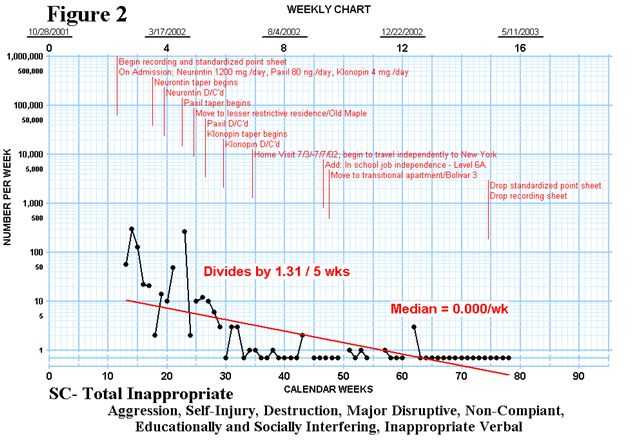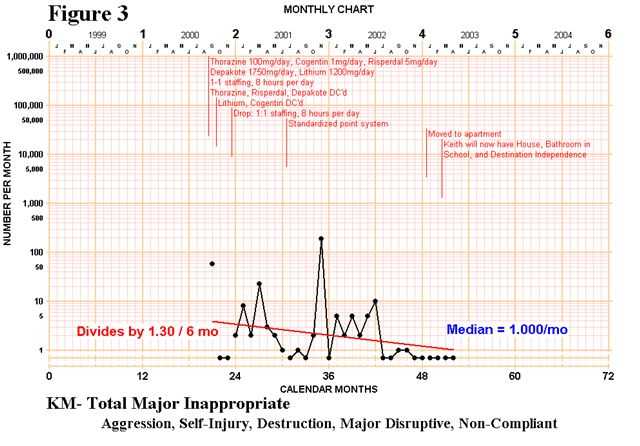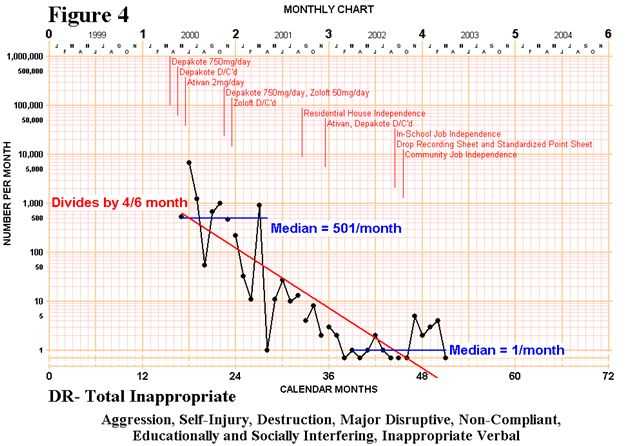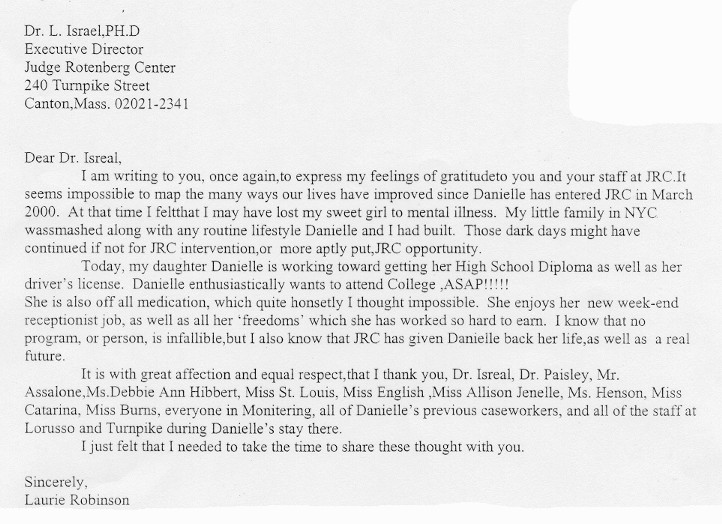
|
Use of Skin-Shock at the Judge Rotenberg Educational Center (JRC) |
Effects of Positive-Only Behavioral Programming to Replace the Need for Psychotropic Medication to Control Behavior
Lynn Parrillo, Patricia Rivera, Ph.D., Matthew L. Israel Ph.D., Cherie Boisvert
The Judge Rotenberg Educational Center
Canton, MA 02021
The Judge Rotenberg Educational Center operates day and residential programs for children and adults with behavior problems, including conduct disorders, emotional problems, brain injury or psychosis, autism and developmental disabilities. The basic approach taken in all of JRC's programs is the use of behavioral psychology and its various technological applications, such as behavioral education, programmed instruction, precision teaching, behavior modification, behavior therapy and behavioral counseling. From JRC's inception, its basic philosophy has always included the following principles: a willingness to accept students with the most difficult behavioral problems and a refusal to reject or expel any student because of the difficulty of his or her presenting behaviors; the use of a highly structured, consistent application of behavioral psychology to both the education and treatment of its students; a minimization of the use of psychotropic medication; and the use of the most effective behavioral education and treatment procedures available.
INTRODUCTION
The data presented resulted from the use of consistent application of positive behavioral programming with individuals that were unsuccessfully treated with medication, psychotherapy and other forms of treatment. The individuals studied were placed on a token economy system, which included the use of "DRO" contracts in varying time lengths and the use of a standardized point sheet. (see Figure 1) A rich variety of rewards were made available in all settings 24 hours per day contingent upon behavior and point earnings for the day. Changes to behavioral programs were made based on daily data collection, which was transferred to computerized standard celeration charts for immediate review to enable effectiveness. This study will present three case studies in which psychotropic medication was discontinued while targeted problematic behavior categories decelerated to a median of 0 per week. Due to the absence of the psychotropic medication and the non-occurrence of targeted problematic behaviors the individuals studied focused and improved upon their educational, social and emotional goals.
METHOD
Positive-only programming was implemented and medication tapering began with the supervision of a psychiatrist with the three individuals upon their admission to JRC. This treatment included positive reinforcement such as tokens or points, verbal praise and tangible rewards for performing appropriate behaviors and refraining from inappropriate ones. Social reprimands as consequences for inappropriate behavior, and ignoring of certain problematic behaviors were also incorporated into the students’ behavior modification programs. Behavioral contracts of varying lengths (range: 1 minute to 1 month) were also implemented. Students passed these contracts by withholding inappropriate behavior. This allowed the students to use their points or tokens to purchase rewards such as money, access to the arcade, breaks, special food, peer socialization opportunities, field trips, and living at less restrictive residences. If the students exhibited a major inappropriate behavior such as aggression, destruction, health dangerous, major disruptive or non-compliance they received a point/token fine as well as having one or many contracts broken. They were placed on a “Loss of Privilege” period where they were not allowed access to rewards for a specified length of time. Contracts were reset based on students’ exhibiting appropriate behavior. Inappropriate behaviors, points/tokens earned, and contracts passed were recorded 24 hours a day. Data was converted into standard behavior charts which allowed for daily, weekly, monthly and yearly monitoring of behavior.
PARTICIPANTS
Participants for this study were three students currently attending the Judge Rotenberg Center (JRC). The students ranged in age from 16 to 21 and participated in all aspects of JRC’s residential and educational programming. All students were referred to JRC by their respective school districts due to their inability of being maintained within a regular school setting. They exhibited maladaptive behaviors such as aggression, destruction, non-compliance and self-abuse that interfered with their educational and social growth. Two of the three participants had multiple psychiatric hospitalizations prior to admission. All of the students have also received at least one psychiatric diagnosis and two out of the three were involved in special education at an early age. Alternative treatments for the students’ behavior problems prior to JRC included individual therapy, group therapy, behavior modification and medication management, all of which proved to be ineffective in treating their maladaptive behaviors.
Participant #1: S.C. (see Figure 2)
21 year-old male
Diagnoses included:
· Anxiety Disorder
· Dysthymic Disorder
· Developmental Learning Disorder
Borderline IQ of 70
Past medications include:
· Paxil
· Clonazepan
· Klonopin
· Neurontin
· Imipramine
Problematic behaviors exhibited prior to JRC placement:
· Aggression towards peers
· Multiple suicide attempts
· Non-compliant to leave house, travel or attend school. Reports indicate “he was unable to leave his own home due to panic attacks, phobias, extreme anxiety.”
Participant #2: K.M. (see Figure 3)
16 year-old male
Diagnoses included:
· Mild Mental Retardation
· ADHD
· ODD
· Mixed Receptive/Expressive Learning Disorder
Full Scale IQ of 43
Past medications include:
· Adderal
· Risperdal
· Cogentin
· Lithium
· Zyprexa
· Depakote
Problematic behaviors exhibited prior to JRC placement:
· Aggression towards teacher/parents
· Violent outburst at home/school
· Verbally and physically confrontational
Multiple psychiatric hospitalizations due to aggressive behavior
Participant #3: D.R. (see Figure 4)
19 year-old female
Diagnoses included:
· Bipolar Disorder
· Conduct Disorder
Full Scale IQ of 103
Past medications include:
· Depakote
· Zoloft
· Ativan
· Lithium
· Zyprexa
Problematic behaviors exhibited prior to JRC placement:
· Physical and verbal aggression
· Suicidal ideations and attempts
· Truancy
· Elopement
· Bizarre Speech
Multiple psychiatric hospitalizations
RESULTS
Results of this study indicate a significant deceleration in the individuals’ inappropriate behavior as a result of positive programming through the use of rewards. As displayed in Figures 1, 2 and 3, targeted behaviors continued to decelerate during the medication taper and remained at low frequencies. All of the individuals transitioned into JRC’s least restrictive residences and participate in regular home visits. Two of the three individuals have part-time in-school jobs, while the third individual works in the community at a day care center. All participants in this study continue to be free of medication, exceeding their educational goals and working towards their transition into the community.
Figure 1
| DATE: | / / | ||||||||||
| Behaviors that earn points | Points | Occurrence | 9 PM | 10 PM | ON | 6 AM | 7 AM | 8 AM | 9 AM | 10 AM | 11 AM |
| 1000 points a day towards Positive behaviors and Contracts | |||||||||||
| 600 points towards academics | |||||||||||
| 200 points towards self-management | |||||||||||
| 200 points towards program-ops | |||||||||||
| WEEKEND ACADEMIC BEHAVIORS THAT EARN POINTS For Weekends, Holidays, and DAR's ONLY) | |||||||||||
| Student engages in Extra -Academics: (1000 point maximum per day) | 5 | per minute | |||||||||
| Student has Self-Management Log up-to-date | 200 | once per day | |||||||||
| You should never exceed the point amount for any entry | |||||||||||
| BONUS POINTS | |||||||||||
| Bonus points given by CM, Clinician, Treatment Department | |||||||||||
| TOTAL POINTS EARNED | |||||||||||
| FINES | |||||||||||
| Breaking Multi-Day Contract | lose all | ||||||||||
| Any additional MTD behaviors | 500 | each | |||||||||
| Inappropriate Verbal Behaviors | 500 | each | |||||||||
| ED/SOC-excluding "Performing a learned task incorrectly" | 100 | each | |||||||||
| Performing a learned task incorrectly | 50 | each | |||||||||
| Going over the allotted time for self-care | 10 | per minute | |||||||||
| Failure to answer incoming call (call waiting) | lose all | ||||||||||
| Solicit staff attention in class for non-academic reason | 250 | each | |||||||||
| Failure to hand in MTD receipts | 1000 | each | |||||||||
| Failed Program op | 100 | each | |||||||||
| Failure to follow House/Classroom rules | 100 | each | |||||||||
| Noisy/Talking during transition | 1000 | each | |||||||||
| Failed assignment/test (CEC) | 250 | each | |||||||||
| Failure to return clothing/items from home visit | 5000 | each | |||||||||
| Failure to meet academic par (CEC) | 250 | each | |||||||||
| TOTAL POINTS LOST | |||||||||||
| REWARDS | COST | PER | |||||||||
| Use of the student printer (excluding paper needed for Academic Contract) | 25 | per sheet | |||||||||
| Appt. w/ clinician | 50 | minute | |||||||||
| Appt. w/ case mgr. | 1 | minute | |||||||||
| Appt. w/ Administrative staff | 30 | minute | |||||||||
| Field Trip (AM) | 250 | trip | |||||||||
| Field Trip (PM) | 500 | trip | |||||||||
| Field Day | 300 | visit | |||||||||
| Big Reward Store (entry) | 200 | visit | |||||||||
| Phone Calls (incoming) - over 2 per week | 25 | minute | |||||||||
| Phone Calls (outgoing) - over 2 per week | 50 | minute | |||||||||
| Healthy Snacks (I.e. fruit, raw vegetables, salad) | 25 | each | |||||||||
| Un-healthy Snacks (I.e. soda (excl. diet), chips, popcorn) | 250 | each | |||||||||
| Diet soda | 100 | each | |||||||||
| Leisure Time | 1 | minute | |||||||||
| Saturday, Sunday Night Special - All rewards listed below are 1 point per minute (5pm to 11pm) - Mark in leisure time. | |||||||||||
| For all Items listed below, student will be charged for leisure time IN ADDITION to cost of item | |||||||||||
| Purchase of TV/Radio/Headphones/Walkman | 5 | minute | |||||||||
| Any Video Games,"Dreamcast" , "Play Station", "Game Boy" | 10 | minute | |||||||||
| Computer/Internet Use | 10 | minute | |||||||||
| Outside Activities (I.E. basketball, bike riding) | 10 | minute | |||||||||
| Staying up late (Weekends, Holidays, DAR's ONLY) | 1 | minute | |||||||||
| Playing cards/ board games | 5 | minute | |||||||||
| Sleeping late on Sat. and Sun. - after 8am until 10am | 1 | minute | |||||||||
| TOTAL POINTS SPENT | |||||||||||
| TOTAL POINTS | |||||||||||
| RUNNING TOTAL | |||||||||||
Figure 2

Figure 3

Figure 4

Figure 5
-----Original Message-----
From: Pickens, Claire V. (LNG)
Sent: Monday, July 08, 2002 9:35 AM
To: 'Lu, Jefferson'
Subject: RE: Student of the week
THIS IS INCREDIBLE NEWS!!!!
I am just signing on to my e-mail. This is my business connection so I was not online form July 4th until now. Therefore, I was unable to inform S of this honor.
Please let him know and also please express the pride his parents feel in seeing this progress.
I must tell you that we had the most wonderful home visit. I think S fifteen year old brother said it best... " S changed in size and attitude". S was so kind and peaceful and cooperative. Suddenly July 4th took on and entire new meaning for me, Not only was I celebrating our country's independence but I was seeing my son "becoming free from the intense fears, anxiety and frustrations that have totally paralyzed his life, education and development.
I am witnessing a miracle and I am so grateful to you and the staff of JRC!!!!
P.S. S spoke so kindly/highly of you. I believe your honesty and compassion have really influenced him. Thank you for extending yourself both professionally and personally.
Figure 6
![]()
![]()
![]()
![]()
![]()
![]()
![]()
![]()
